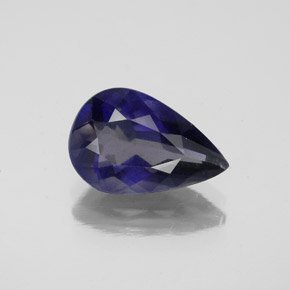The Gemstone Iolite

Iolite is the gem variety of the mineral
Cordierite. It describes the transparent to translucent form of Cordierite, and it has recently become a popular gemstone. Iolite can be light to deep blue, and usually has a purplish tinge to it. Deeper colored stones are more valuable. Iolite is very affordable and durable, and can be used as a substitute for more expensive blue gemstones such as
Sapphire. It is named from the Greek "violet", alluding to the purplish tinge often exhibited by this gemstone.
Color
?
Blue, Purple, Gray
Chemical Formula
?
Mg
2Al
4Si
5O
18
Mineral Class
?
Cordierite
Additional Properties
|
Refractive Index
?
1.55 - 1.62 |
Double Refraction
?
-0.01 |
Transparency
?
Transparent to translucent |
SG
?
2.6 - 2.7 |
Luster
?
Vitreous |
| Cleavage ?
3,1 |
All About
Iolite is strongly
pleochroic, and will exhibit a different color when viewed at different angles. In fact, it is the most
pleochroic gemstone, with this effect being clearly noticeable on all transparent Iolite gemstones. A blue or violet-blue Iolite gemstone will become a duller gray or grayish-yellow when viewed at a different angle. For this reason, care must be taken by gemstone cutters to facet Iolite gemstones so that their colors are oriented with the intense blue or violet showing from the top.
Uses
?
Iolite is cut into gemstone facets and
cabochons, and is used in all types of jewelry, especially rings, earrings, and pendants.
Treatments & Enhancements
?
Iolite gemstones are natural and not treated or enhanced.
Iolite Sources
?
Iolite gem deposits are Madagascar, Myanmar (Burma), Sri Lanka (Ceylon), India, and Brazil.
Similar Gemstones
?
Sapphire - Lacks
dichroism, greater
hardness.
Iolite in the Rough Photos
?